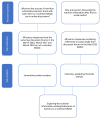Using the Internet: Nutrition Information-Seeking Behaviours of Lay People Enrolled in a Massive Online Nutrition Course
- PMID: 32178291
- PMCID: PMC7146568
- DOI: 10.3390/nu12030750
Using the Internet: Nutrition Information-Seeking Behaviours of Lay People Enrolled in a Massive Online Nutrition Course
Abstract
People's accessibility to nutrition information is now near universal due to internet access, and the information available varies in its scientific integrity and provider expertise. Understanding the information-seeking behaviours of the public is paramount for providing sound nutrition advice. This research aims to identify who learners in a nutrition-focused Massive Open Online Course (MOOC) turn to for nutrition information, and how they discuss the information they find. A multi-methods approach explored the information-seeking and sharing behaviours of MOOC learners. Summative content analysis, and an exploratory, inductive, qualitative approach analysed learners' posts in MOOC discussion forums. From 476 posts, the majority (58.6%) of nutrition information sources learners reported were from websites. Providers of nutrition information were most commonly (34%) tertiary educated individuals lacking identifiable nutrition qualifications; 19% had no identifiable author information, and only 5% were from nutrition professionals. Qualitative themes identified that learners used nutrition information to learn, teach and share nutrition information. Consistent with connectivist learning theory, learners contributed their own sources of nutrition information to discussions, using their own knowledge networks to teach and share information. Nutrition professionals need to understand the principles of connectivist learning behaviours in order to effectively engage the public.
Keywords: information-seeking behaviour; nutrition education; nutrition misinformation; online learning; social media.
Conflict of interest statement
The authors declare no conflict of interest.
Figures
References
-
- O’Reilly T. What Is Web 2.0 2005. [(accessed on 11 November 2018)]; Available online: https://www.oreilly.com/pub/a/web2/archive/what-is-web-20.html?page=1.
MeSH terms
LinkOut - more resources
Full Text Sources




